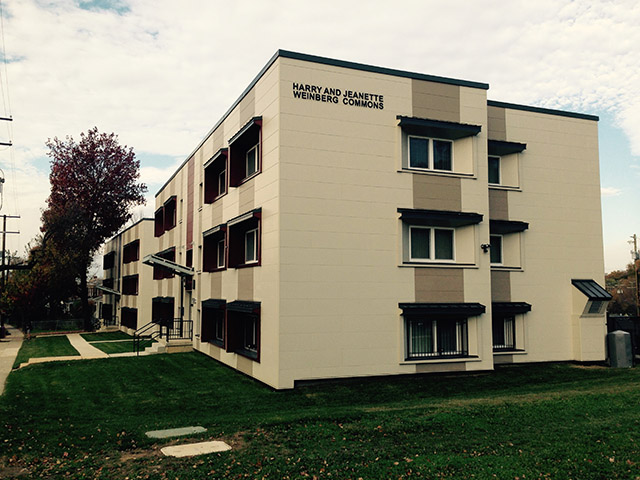Source: eesi.org
Published: November 18, 2015

DC Mayor Muriel Bowser at the ribbon-cutting ceremony for the Harry and Jeanette Weinberg Commons. EESI Chairman Jared Blum is the second from the left (Photo by Khalid Naji-Allah)
Author: Michael Martina
Weinberg Commons in DC Retrofitted to Passive Building Standards
This morning Reneé Jones and Michael Royce both woke up in their respective state-of-the-art, sleek, ultra-sustainable, and incredibly efficient “passive” houses. The difference between the two: Royce is a retired lawyer/CEO who built his energy efficient home from scratch in Portland, Oregon, whereas Jones just moved into a retrofitted low-income building in southeast Washington, DC, after being homeless for the past 6 years.
As a cutting-edge environmentally-friendly architectural technique, passive design has mostly been used for new construction in wealthy, affluent areas. However, the recent opening of Weinberg Commons in Washington, DC, shows that existing multifamily buildings can also be made highly energy efficient with cost effective upgrades.
When it first started working on the Weinberg Commons project in November 2014, the Transitional Housing Corporation (THC), a faith-based nonprofit, sought to refurbish three blighted buildings in Southeast DC into affordable housing for low income families. Rather than keep upfront costs as low as possible, THC took a holistic approach. It knew that, over the long run, energy-efficient homes are much more affordable than conventional ones.
|
|
|
Weinberg Commons (Courtesy of Michael Hindle, Certified Passive House Consultant from Passive to Positive) |
In order to make them highly energy efficient, the Weinberg Commons buildings were retrofitted with some of the most advanced building technology on the market. Design Project Manager Matt Fine of ZAVOS Architecture + Design steered the challenging task of transforming the derelict buildings into ones which meet Passive House standards and principles. As described in a past EESI briefing, buildings designed or renovated to “passive building” standards are equipped with first-rate insulation, triple-paned windows, and energy-recovery ventilators that ensure a constant supply of clean air with minimal energy usage. In the case of Weinberg Commons, the buildings are also equipped with solar panels, which are expected to cover all of the electricity needs (instead of the 20-30 percent that would be saved in a conventional building equipped with solar panels).
“The goal of passive building design is to control the indoor environment, the key to achieving deep energy savings, comfort, healthful air quality, and other aspects of sustainable, affordable housing,” noted EESI’s Ellen Vaughan. “Passive building standards are very exacting—not rocket science but the best of building science plus modern materials and technologies. Bringing this to affordable housing is one of the best uses of public-private partnerships and resources. It’s a win for people, the planet, and the economy.”
Passive building design is the combination of Passivhaus (an energy efficient building standard developed in Germany) and passive solar techniques, which help homes passively absorb heat during the winter and reject it during the summer. Together, these practices have been proven to reduce heating and cooling energy use by up to 90 percent compared to conventional construction with non-airtight building envelopes.
Although passive buildings have typically been single-unit structures, a number of multifamily buildings are meeting this rigorous energy efficiency standard. Weinberg Commons will provide homes for 36 low- and moderate-income families, including 12 families who were previously in the D.C. homeless shelter system.
Jared Blum, president of the Polyisocyanurate Insulation Manufacturers Association (PIMA) and EESI’s chairman, noted, “Because utility costs can be some of the largest expenses faced by a family, passive house design allows people to better budget their money for other things such as education, food and family enrichment.” PIMA donated polyiso insulation to the project.
THC leaders are optimistic this prototype will inspire more projects like it, as D.C. officials seek to provide shelter to the estimated 7,500 homeless individuals in the city. “Numbers-wise, it’s 12 units, and there are a lot more families in the D.C. homeless population than that. But it’s a start, and it’s a successful start,” reflected Kimball Griffith, who chairs the THC board. “The hope would be that it generates momentum and shows people what can be done.”
For more information on sustainable buildings, please visit EESI’s Buildings page.

